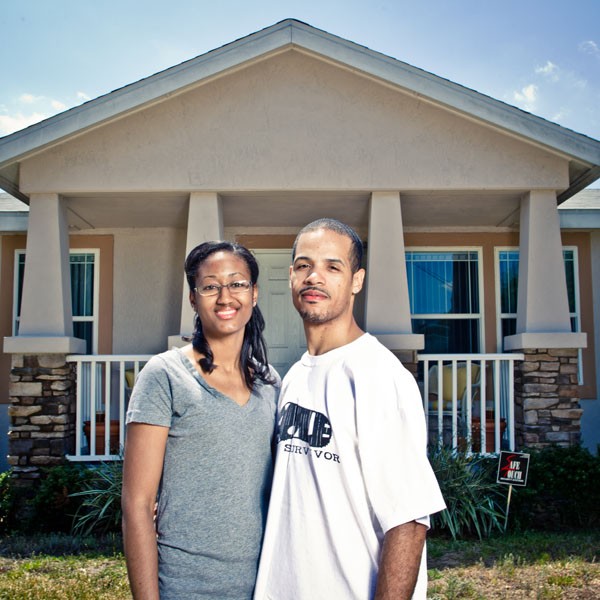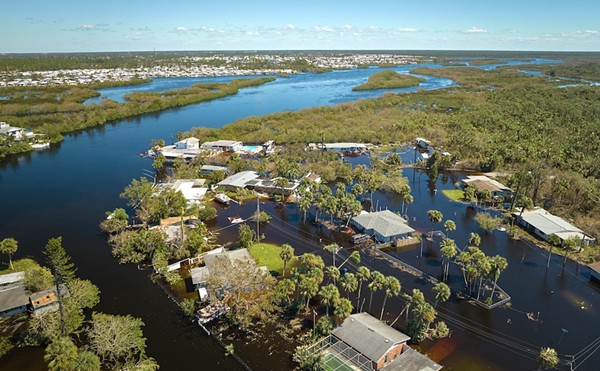When Mary Daniels was a teenager, her Hungerford High School social studies teacher sent her on a mission: She was dispatched to the Winter Park Chamber of Commerce to look for a copy of something called the "10- to 20-year plan," a meticulously detailed master plan that laid out a strategy for development in the city.
In it, Daniels learned, the city – which has long been home to an established African-American community in the Hannibal Square area just west of downtown – proposed encouraging black residents to move away from Winter Park’s center and closer to Maitland.
At the time, Daniels didn’t find the revelation all that shocking or appalling – it was 1962, she was just a teenager and 20 years seemed like a long time away. Even if the 10- to 20-year plan did cause black families to relocate, she figured, she probably wouldn’t be around to see how it affected the community.
More than 40 years later, though, Daniels is still here. She now not only lives in Winter Park, she’s also deeply vested in what happens to it – and to what’s left of the African-American community that remains in Hannibal Square.
Daniels is the president of the board of the Hannibal Square Community Land Trust, a nonprofit organization founded in 2004 to preserve affordable housing – and the legacy of the African-American families who first settled in Hannibal Square in the 1880s – in the Winter Park Community Redevelopment Area.
The CRA, as it’s more commonly known, was adopted by Winter Park in 1991 and spurred a flurry of growth that drove housing prices beyond the means of many of the black families who were living there.
The Hannibal Square Land Trust, the first of its kind in Central Florida, tries to combat the displacement of low- and middle-income families from Hannibal Square by taking a new approach to homeownership. The organization builds affordable, attractive new houses on plots of land donated to it by the city. It sells the homes to qualified low- and middle-income buyers who meet certain criteria: they must be first-time homebuyers who are residents or former residents of Winter Park, they must live in the home as their primary residence and they must qualify for the home based on income and family size. If they’re approved for a mortgage, they get to purchase a brand-new home in downtown Winter Park for less than what it would be worth if sold on the open market.
There’s just one catch: The homebuyers own the home, but not the land the house sits on, which belongs to the nonprofit land trust. Residents have a 99-year renewable lease on the land, which they can pass down to their children. They can also sell the homes after a certain number of years (to prevent property flipping, buyers must live in the homes for a period before selling), but they only keep 25 percent of the equity in the house. After a house is sold, the other 75 percent goes back to the land trust to help it fulfill its mission of providing affordable housing in Hannibal Square. The land-trust model is praised by supporters for helping maintain affordable housing options in areas where real estate values have skyrocketed beyond the reach of the average homebuyer.
Though the Hannibal Square Land Trust is still in its infancy, it has completed and sold 14 houses so far along West Comstock and Canton avenues, it has one on Symonds Avenue that’s currently for sale and it has rehabbed a house on Virginia Avenue. For the first five years it was in existence, the CRA provided funding to help the organization get its feet under it, and the city of Winter Park donated the parcels of land upon which the land trust’s houses sit. That funding source has expired, though, and some of the parcels the land trust owns are vacant, waiting to be developed.
The organization, which says it’s about not just building and selling inexpensive houses, but also about building a healthy community, is now looking for new sources of revenue (and partnerships with other organizations) to help it fulfill that mission.
Winter Park’s CRA originally focused on enhancing downtown, its commercial strip along Fairbanks Avenue and areas immediately west of downtown. The CRA has expanded over the years, and today it reaches as far south as Rollins College and as far north as Lee Road; it reaches down a long stretch of Fairbanks Avenue to the west and Interlachen Avenue on the east.
Hannibal Square falls solidly within its boundaries and is, in fact, one of the communities specifically targeted by the original CRA as ripe for improvement and economic development.
Like the 10- to 20-year plan that came decades before it, the CRA lays out future development plans for the city; unlike the earlier plan, it did not try to push the African-American community to the fringes of the city – at least not intentionally.
The CRA has been largely credited with improving the areas of the city where it operates – when it was first adopted, swaths of the city were in decline, prone to blight and crime and disinvestment.
"There was significant criminal activity, and it bred the social problems associated with alcohol, drugs and homelessness that spilled over into the surrounding neighborhoods," says Dori DeBord, director of the Winter Park Community Redevelopment Agency, which manages the city’s growth under the Community Redevelopment Area plan.
The CRA gave the city a vehicle to use tax dollars to work on street beautification, increased code enforcement, infrastructure improvements and creation of new commercial-development opportunities by private interests. Developers constructed new residential/retail complexes that catered to a more well-to-do clientele – development on a scale that many felt was not in keeping with the neighborhood’s character.
One developer in particular, Dan Bellows, who was behind the development of a cluster of mixed-use buildings on New England Avenue, butted heads repeatedly with the community over conflicting visions for the area’s future. Bellows gained notoriety within the community as a ruthless, polarizing figure who was insensitive to residents’ desires. In a 2005 story in the Orlando Business Journal, he was quoted as saying that the community was "dying a slow, natural death," and that his development was going to improve the area. Bellows declined to comment for this story.
The tony shops and restaurants that line Park Avenue soon began to spill over onto Fairbanks and New England avenues, which abut Hannibal Square; newer buildings replaced vacant lots and neglected properties.
"The overall city population viewed the changes and transformation positively," DeBord says. "The surrounding neighborhood viewed the changes positively because it made their neighborhoods safer as the crime and homelessness were reduced."
But many residents of Hannibal Square felt like they were being marginalized by the development. They resented the fact that the vision for Winter Park’s growth didn’t seem to include them.
According to DeBord, "there was a feeling that the businesses catered only to the white community and that they were all left out of gentrification."
Julian Chambliss associate professor of history and coordinator of the African and African-American studies program at Rollins College, and an advisory board member for the Hannibal Square Community Land Trust, is more blunt: "This is when you get a full-on pushback from the African-American community," he says. "Residents thought the city was trying to push out the historically black community, and efforts to improve communities created pressures against keeping Hannibal Square black."
p>
At the time the CRA was first adopted, Daniels says, she wasn’t really aware of what it would mean for her neighborhood on West Canton Avenue. "I had always worked in Orlando and gone to church in Orlando, so I spent the night in Winter Park," she says, sipping an iced green tea at the Panera Bread café on Park Avenue. "They used to have CRA advisory board meetings at the old community center, and a friend told me one day, ‘You really need to come to this meeting about rezoning.’"
She attended the meeting and was alarmed at what she saw.
"They had this board up there with a street map, and the streets were coded in yellow and orange," she says. "I asked what the color coding meant. Yellow was R-1 zoning and orange was R-2 zoning and so on. I looked and saw a lot of orange where I lived on Canton."
R-1 zoning is single-family residential; R-2 zoning allows for the development of both single- and multi-family homes – townhouses and duplexes and denser development. That clashed with the vision Daniels and her neighbors had for their neighborhood.
"I didn’t know who requested that zoning change," Daniels says, and she quickly discovered that getting it changed back was not as simple as just complaining to City Hall.
She and a group of neighbors created a task force to survey the community to find out what it wanted its future to be, and they presented their findings to the city. Eventually, the task force managed to get the rezoning appealed. Daniels realized then that the community needed to mobilize if it was going to have a say in its future. She thought back to her 1962 high school assignment. "My teacher was trying to help us understand what was happening in our neighborhoods," she says. "It’s important for everyone to be aware of what’s happening to their communities."
She and other members of the Hannibal Square area presented their concerns to the city and the CRA; they proposed that they form an organization that would ensure that some affordable housing options would always be available in the community so that the African-American families who wanted to stay in the neighborhood would not be edged out by gentrification.
The CRA created the Hannibal Square Community Land Trust, a nonprofit organization that would have a tripartite board made up of members appointed by the city, the Hannibal Square community and residents who purchased homes from the trust. The city donated parcels of land to the trust and the CRA pledged funding for the organization’s first five years.
According to Denise Weathers, the trust’s executive director, the city "provided land and technical expertise and was a partner in acquisition and development." The first houses were built in Canton Park on the site of what Daniels describes as a dilapidated, poorly managed apartment complex. The cluster of craftsman-style homes with spacious front porches sits just off West Canton Avenue, accessible from a new street called Israel Simpson Court, named after the first aldermen of Hannibal Square. The houses were offered up for sale for $126,000 each; according to Orange County property records, they all sold in early 2006.
Since then, the organization has built four modular homes, built to green standards, on West Comstock Avenue; property records indicate that those houses sold for anywhere from $115,000 to $155,000.
Removing the cost of the land from the sales equation is what helps land trusts keep prices low in perpetuity – no matter how coveted the parcel of land on which a home sits may become, the value remains with the trust, so the price of the homes remains lower than those of other homes in the community.
The trust also prepares its buyers for the responsibilities that come with homeownership. It requires buyers to attend educational workshops and classes before and after purchase. The trust says the diligence pays off.
"When the foreclosure market hit," Weathers says, "the land-trust foreclosure rate was at 1 percent, while the rest of the market was in double digits. Not one of our Hannibal Square Community Land Trust homeowners has even come close to foreclosure."
Even during the housing slump, says Weathers, owners of land-trust houses have been able to maintain some equity in their homes, whereas many owners of houses bought at market rate during the real estate boom are now underwater on their mortgages.
In exchange for buying into the land-trust concept, homeowners have to be willing to compromise – and that can be difficult for some potential buyers to swallow.
The 99-year-lease is integral to the land trust’s ability to keep home prices affordable, Chambliss says, but some potential buyers bristle at the concept of letting another organization control the land their home sits on.
"The enshrinement of personal property is woven so deeply into the American fabric that sometimes it goes against logic," he says. "In America, property ownership equates to fully functional citizenship. You do not get to own the land with the HSCLT, and a lot of people fundamentally don’t like that. Historically and culturally, it seems a little off. It smacks as some kind of trick. But land has to be removed from the equation to keep the cost down."
If land trusts didn’t retain ownership of the land, they wouldn’t be able to control what happens to the home once it sold. Its model wouldn’t be much different than, say, Habitat for Humanity, which renovates or builds affordable homes that it sells to lower-income families. But when a house built by Habitat for Humanity is resold, it doesn’t necessarily remain affordable; it goes on the market at full value, potentially pricing out low-income buyers.
When a land-trust home goes up for resale, the new buyers must meet the same criteria the original buyer did, and the majority of the equity from the sale stays with the trust.
Land trusts collect ground-lease fees from their buyers, as well, which are funneled back into the treasury to sustain and expand programs. (Hannibal Square’s ground-lease fee is $45 per month.) In a 2008 report by the Lincoln Institute of Land Policy think tank in Cambridge, Mass., researchers noted that ground-lease can generate substantial revenues for some land trusts. The Thistle Community Land Trust in Boulder, Colo., for instance, generates a third of its income from ground-leases.
But what land-trust supporters see as innovations in affordable housing, some see as an incomplete sketch of actual homeownership – something that benefits the organization but not so much the homeowner. Mary Daniels says that she was initially opposed to the land-trust idea, but says she eventually realized that the concept was as much about preserving the community as it was helping individual owners, so she relented. "It’s not all about Mary Daniels," she says. She and the other board members interviewed for this story all say the land-trust concept is not for everyone.
It wasn’t for Angela Thomas, who was interested in buying a home in the Hannibal Square neighborhood back when the land trust was just getting started. When the trust board heard about her experience in mortgage processing, she says, they recruited her as a member. But when a land-trust consultant was brought in from Key West to introduce the concept, Thomas’ enthusiasm dissolved.
"I’ll give you three reasons why I didn’t like the land trust," she says. "One, there’s value in land, so I wanted to own the land. Two, the land trust changed some rules. When I was on board, homeowners would not have had to pay the property taxes on the land they didn’t own, and now they have to. Three, it’s a modern-day plantation. Once the house deteriorated, I would have nothing."
She left the board and ended up buying a home in Eatonville, land and all.
Weathers has heard the criticisms before. She counters them by saying that the goal of the land trust is not to help people buy "a dream home." Rather, she says, it’s a way for people who don’t have the means to purchase a home for the first time to build a little equity, which they can’t do while renting.
"This is a starting point, where you can increase your wealth," she says. "When you die, you’re not going to see a U-Haul attached to your hearse with your land."
She also says that the reason the homeowner, rather than the land trust, pays the property taxes, is because taxes are based on both the value of the land and improvements to it. Since the trust owns the land the home sits on, land-trust homeowners only have to pay taxes for the improvements to the property.
"Since the homeowner owns the improvement, that’s what their taxes are based on," Weathers says. "Since the HSCLT is a nonprofit organization, we are exempt from paying taxes, thereby being a benefit to the homeowner by reducing their tax rate."
The Hannibal Square Community Land Trust was founded during a housing boom, but that boom is long over. The economy is lagging, and real estate values have plummeted throughout Central Florida – one might wonder if the program is still even necessary at a time when median home prices in Central Florida are at historic lows.
"With the economy upside down, it’s easier to have a home in Winter Park," Weathers acknowledges. "But the market will turn back around, and the developers will be waiting in the wings, ready to move in."
Which is why she says the organization has to get creative to keep itself viable in the tight economy. The coffers have not run dry – according to tax forms filed by the IRS, the organization took in $68,557 in grants and contributions in fiscal year 2008, and in 2009 it took in $253,910 in grants and contributions and ended up with $136, 729 in revenues after expenses – but development projects are not cheap, so the organization is concentrating on raising money (board president Daniels says the trust’s next project may be along New England Avenue, though nothing is certain in this shaky economy).
"We’ve had to establish a line of credit and take fundraising more seriously," Weathers says.
At the moment, there are not any 99-year-lease homes for sale; instead, the land trust has a home located on Symonds Avenue for sale at full market price to generate income. It has also been collaborating with two other nonprofits – the Welbourne Avenue Nursery and the Hannibal Square Heritage Center – on a benefit called "The Legacy," which raises funds to support the three organizations dedicated to preserving Hannibal Square’s heritage.
The organization also found out in March that the ground-lease model utilized by land trusts across the country was recently approved by Fannie Mae. It was a huge coup in securing the financial futures of land trusts like Hannibal Square, because it opens doors for new financing options for people who want to buy in. Federal Housing Administration loans are consistently denied for land-trust properties, and many mortgage companies don’t want to work with land trusts because of the resale and ownership restrictions. For instance, the Hannibal Square Land Trust does not allow for mortgages used to purchase land-trust homes to be sold on the secondary market.
BankFirst of Winter Park is currently the sole mortgage provider for the land trust. John Casebier, BankFirst’s president, says that banks usually don’t like to work with land trusts because the foreclosures can be complicated. For the average homeowner, the property serves as collateral against the mortgage; banks lend homeowners money because they have clear leverage in the event of loan default. If a land-trust homeowner defaults, though, the bank’s interests in the home are second to the land trust’s interests, so banks could have trouble taking possession and getting the money back.
Casebier says that BankFirst "felt the benefit to our community and market outweighed any risk."
p>
Denise Weathers works from a small office near the Mount Vernon Inn and BankFirst. Poised and immaculate in her white oxford shirt, she says she got involved with the land trust a few years ago, after the former executive director stepped down. Weathers says she was a fundraiser for the Urban League, so she was "privy to a lot of inner workings within Winter Park."
"I know the ins and the outs of the land-trust model," she says. "I know the dynamics between the land trust and the city."
She also knows that the history of development in Winter Park is fraught, and she wants the land trust to play a larger role in shaping the community’s future.
She sees the trust as more than just a smattering of houses on the west side.
"The land trust is also about restoration," she says. "We’ve lost minority businesses. We can bring some of those viable African-American businesses back. We can be that agent that can lead to change."
She says that affordable housing doesn’t have to be the stereotypical image of low-income tenements and projects. The land trust’s houses – bright, comfortable, three bedroom homes beneath shady trees – maintain the quality and character of the historic area and can be a model for what affordable housing should be.
"The community is walkable, it has a community center, events, farmers markets, parks, a college," she says. "This is healthy living." p>
It’s that kind of living that attracted Marketa Hollingsworth, who grew up in Hannibal Square, to buy into the land trust. In 2007, after graduating from Florida A&M University in Tallahassee, she moved back into her parents’ home. She figured she would look for an apartment, but her father told her about the land trust, which was working on its second phase of houses – the modular homes on Comstock Avenue.
At first, she wasn’t crazy about living in a modular, but when she went to look at the houses, she was impressed. She saw that they were factory-built but installed permanently on their foundations, and they blend easily into the neighborhood of single-family homes. Hollingsworth decided to apply for one.
Today, she and her husband, Juan (both of whom studied architecture in school) live in the home, and Hollingsworth was so taken with the concept of the land trust that the two now volunteer with the organization – Hollingsworth is its secretary, and Weathers says she’d like Juan to join the advisory board. Without the land trust, Hollingsworth says, she probably wouldn’t have been able to afford to buy a decent home in Winter Park at all, so the 99-year-lease doesn’t bother her. "We don’t need to own the dirt," she says.
Chambliss says the land trust is still a "work in progress," and it’ll take some time, and a lot of effort, to actually be the change agent Weathers says she’d like it to become. But he doesn’t want to diminish their efforts and the success they’ve built so far: "They’ve navigated a tremendous amount of change in a very short time," he says. "They’ve had to define what they are and secure land. This stuff is a big deal. It runs counter to everything that people know."




















